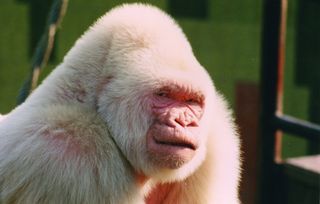

Mutations in the homologous gene underlie pigment dilution in a number of vertebrate species, including gorilla, several breeds of dog, tigers, horses, mice, shrew, chickens, pigeons, quail, frogs, fish and perhaps cattle (Caduff et al, 2017 DeLay et al, 2018 Domyan et al, 2014 Dooley et al, 2013 Fukamachi et al, 2001 Gunnarsson et al, 2007 Mariat et al, 2003 Minvielle et al, 2009 Newton et al., 2001 Prado-Martinez et al, 2013 Rothammer et al, 2017 Tsetskhladze et al, 2012 Tsuboi et al, 2009 Wijesena & Schmutz, 2015 Winkler et al, 2014 Xu et al, 2013), and polymorphisms at the SLC45A2 locus are associated with skin tone differences and skin aging in several human population studies (Adhikari et al., 2019 Branicki et al., 2008 Cerqueira et al, 2014 Fracasso et al, 2017 Han et al., 2008 Jonnalagadda et al, 2016 Law et al, 2017 Liu et al., 2015 Lopez et al, 2014 Soejima & Koda, 2007 Stokowski et al., 2007 Yuasa et al, 2006). membrane associated transporter protein, MATP or antigen isolated from immuno-selected melanoma-1, AIM1) (Newton et al, 2001). We discuss these observations in light of our understanding of chimpanzee behavior.We describe the subsequent infanticide of the individual with albinism.We describe interactions between the infant with albinism and other group members.We report the first observation of a chimpanzee with albinism in the wild.Observations of wild non-human primates with albinism are extremely rare.Finally, we discuss our observations in relation to our understanding of chimpanzee behavior or attitudes towards individuals with very conspicuous appearances. We also describe the subsequent killing of the infant by conspecifics as well as their behavior towards the corpse following the infanticide. Here, we report, to our knowledge, the first sighting of an infant with albinism in wild chimpanzees (Pan troglodytes schweinfurthii), including social interactions between the infant, its mother, and group members. However, while observations of social interactions involving individuals with albinism have been observed in wild non-primate animals, such interactions have not been described in detail in non-human primates (hereafter, primates). Both humans and non-human individuals with albinism face a number of challenges, such as reduced vision, increased exposure to ultraviolet radiation, or compromised crypticity resulting in an elevated vulnerability to predation. Assim, este novo registro de anta albina destaca a importância de preservar e manter a conectividade entre as unidades de conservação daquela região.Īlbinism-the congenital absence of pigmentation-is a very rare phenomenon in animals due to the significant costs to fitness of this condition. Antas albinas foram registradas em outra reserva florestal, a Reserva do Legado das Águas, distante 20 km do local onde o filhote foi resgatado. A anta órfã foi resgatada e levada ao Parque Zoológico Municipal Quinzinho de Barros. Em 23 de novembro de 2020, um filhote fêmea albina foi encontrada na zona de amortecimento do Parque Estadual do Jurupará, no município de Piedade, Estado de São Paulo, Brasil. Neste estudo descrevemos um novo registro de uma anta albina na Mata Atlântica Brasileira.


Resumo: Albinismo em antas (Tapirus terrestris): o relato de um infante órfão da Mata Atlântica. Thus, this new record of albino tapir highlights the importance of preserving and maintaining connectivity among the conservation units in that region. Albino tapirs have been reported in another forest, Legado das Águas Reserve, about 20 km from this calf was rescued. The orphaned female tapir was rescued and brought to Parque Zoológico Municipal Quinzinho de Barros. On November 23 rd 2020, a female albino calf was found within the buffer zone of Jurupará State Park, in the city of Piedade, São Paulo State, Brazil. Here we report the encounter of an albino lowland tapir in the Brazilian Atlantic Forest.


 0 kommentar(er)
0 kommentar(er)
